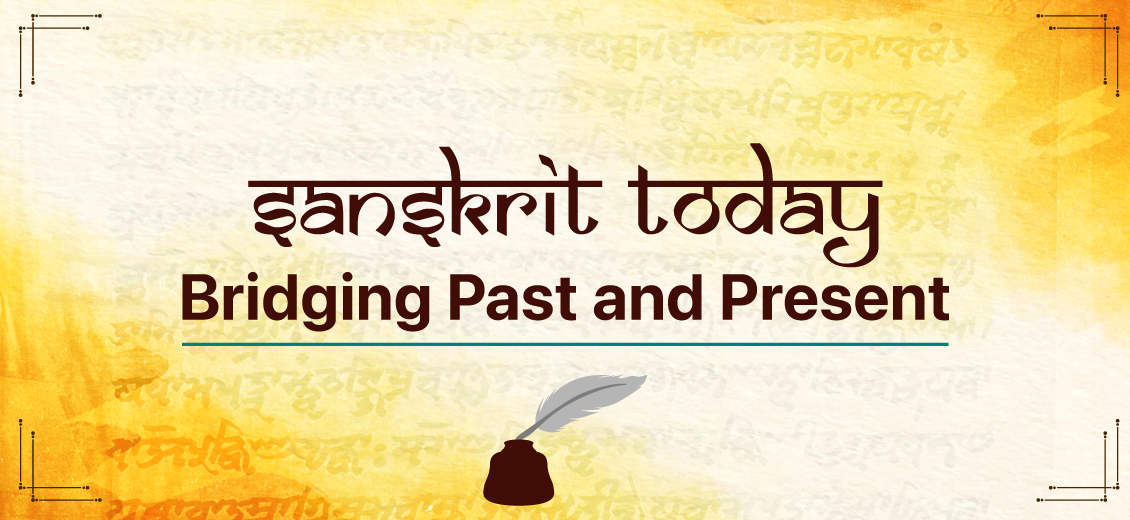Sanskrit Today: Bridging Past and Present
Blogs Home
- 03 Aug 2023

The phrase ‘World Sanskrit Day’ elucidates the connotation of Sanskrit holding a substantial meaning at the global level, ubiquitous to the whole world, which is beyond the identity of being one of the languages of the Indian Subcontinent. Thus, it is important to explore the narrative that the Sanskrit language has around itself, to analyze its various avenues and evolution from the past and present, and to envision the contemporary relevance it has.
Sanskrit belongs to the Satem group of Indo-European languages of South Asia. Besides being an ancient classical language, it is also a liturgical language of Hinduism and Buddhism primarily, and occasionally used in Jainism. It is one of the twenty-two official languages of India and an ancestor of the modern Indo-Aryan languages. Its status in the cultures of South and Southeast Asia is similar to that of Latin and Greek in Europe and it has evolved into and influenced, many modern languages of the world.
The spectrum of literature in the Sanskrit language encompasses a rich tradition of poetry and drama, and religious, scientific, technical, and philosophical texts. Sanskrit has shaped the culture, art, architecture, scientific disciplines, and other aspects of society like polity, philosophy, etc. Today, Sanskrit is widely used as a ceremonial language in Hindu rituals in the form of hymns and mantras.
Originally, the term "Sanskrit" did not emerge as a specific language set apart from other languages, but as a specifically refined or perfected manner of speaking. Knowledge of Sanskrit was a social class marker and educational attainment of the language was a privilege of the higher castes in ancient India.
The Relevance of Sanskrit in Modern Context
Pre-classically known as Vedic Sanskrit, a spoken language for centuries before the Vedas were written down, Sanskrit began the transition from a primary language to a language of religion and learning around 600 BCE. Classical Sanskrit is defined by the oldest surviving Sanskrit grammar, Panini’s Ashtadhyayi. Sanskrit, primarily a learned language of Ancient India thus evolved into modern Indo-Aryan languages.
Although the evolution of Sanskrit has declined its nature of everyday use, it still holds unabashed significance in the modern world. The culture of Sanskrit is a culture of synthesis and assimilation and spreads the message of humanism, peace, and mutual understanding, and of the sound development of the individual and the society. The cultural heritage of India stems from the contribution of Sanskrit in shaping the literature, traditions, monuments, and art of ancient India that has been passed in legacy to us.
Sanskrit Literature and Texts
The vast array of Sanskrit Literature has incepted various Vedas, Upanishads, Puranas, epic poems, drama, and philosophical works. The Vedas are the oldest and most sacred texts of Hinduism, containing hymns, rituals, and philosophy. The Upanishads are the philosophical and mystical teachings of the Vedas. The Mahabharata and the Ramayana are epic poems that narrate the stories of heroes, gods, and demons. The Puranas are mythological and historical accounts of the creation, preservation, and destruction of the universe. This literature was written in the Sutra style, in which brevity is a defining character. The works which have been written in sutra style were named ‘Vedangas’. They are six – Shiksha, Kalpa, Vyakarana, Nirukta, Channdas, and Jyotish.
Classical Sanskrit literature includes plays, poetry, and philosophical works that explore various themes, such as love, morality, politics, and spirituality. Some of the famous authors of classical Sanskrit literature are Kalidasa, Bhartrihari, Shankara, and Bhavbhuti, who have written timeless works like Abhigyan Shakuntalam, Meghdoot, Uttaramcharit, and many more. These Vedic texts are an indispensable part of Hindu rituals today and the classical works are majorly studied around the globe even today.
Sanskrit as a Language of Science and Knowledge
Sanskrit is not only a language of religion and spirituality but also a language of science and knowledge. The texts contain many scientific and mathematical discoveries that were made thousands of years ago. Sanskrit was the first language to describe the concept of zero, the decimal system, the Pythagorean theorem, and trigonometry. Sanskrit also has sophisticated grammar and phonology that are based on human physiology. Sanskrit is a language that reflects the wisdom and creativity of the ancient Indian civilization.
Sanskrit has played a vital role in the development of various scientific disciplines like medicine, astronomy, and maths. Sanskrit texts have documented the knowledge and practices of ancient Indian scientists and physicians, who made remarkable contributions to these fields. For example, the anatomy, pathology, diagnosis, and treatment of various diseases in Ayurveda, the oldest system of medicine in the world. Sanskrit texts have also explained the principles and methods of astronomy, such as the calculation of planetary positions, eclipses, and calendars. Sanskrit texts have also introduced the concepts and techniques of maths, such as algebra, geometry, and calculus.
Sanskrit in Indian Art, Architecture, and Culture
The classical texts have provided the source material, stories, and characters for many traditional Indian art forms, music, dance, and drama. Sanskrit texts, such as the Natyashastra, have also laid down the rules and principles of these forms of expression. Sanskrit has also enriched the language, style, and beauty of these forms. Sanskrit has also helped to preserve and transmit the cultural legacy of India through traditions, customs, rituals, folk tales, and ballads. The association of Indian Music with Sanskrit is as old as Sanskrit itself. In the Vedic age, the Samagana method of chanting Vedic verses was in practice. Music is believed to have originated from the mantras of Samveda.
Sanskrit has played an inevitable role in the development of temple architecture and iconography. Sanskrit texts, such as the Agamas, the Shilpa shastras, and the Vastu shastras, have prescribed the design, construction, and decoration of temples. Sanskrit texts have also described the forms, features, and symbolism of various deities and their images.
Revival of Sanskrit - Challenges and Measures Taken
The major challenges that pose a roadblock to the revival and continuation of Sanskrit can be summarised as the rote method of learning Sanskrit relying on translation, the Western influence of academic theories that portray Sanskrit as a political, oppressive, and dead language, the marginalization of Sanskrit in the education system and the media due to lack of awareness and inadequate resources and the scarcity of appreciation of the language’s value. The loss of Sanskrit manuscripts and oral traditions due to neglect and destruction and the dearth of first-language Sanskrit speakers have also diminished its value and prominence.
Sanskrit is now a language of an ancient culture whose history dates back to 4000-6000 years in the past. But vigorous efforts have been made so that Sanskrit is taught and pursued as a subject in hundreds of educational institutions across India, along with some dedicated language purists who are trying to revive and promote this classical Indian language. Organizations like Rashtriya Sanskrit Sansthan and Sanskrit Bharati have ensured that Sanskrit is encouraged more and more. The Indian Govt. has assisted the prevalence of Sanskrit by providing scholarships and funding to Adarsh Sanskrit Mahavidhyalayas, Shodh Sansthaan, Asthaadashi project, etc. Digital tools and e-content have been curated for ease of students.
Sanskrit Education in India
The educational system in India pertaining to Sanskrit knowledge was widespread in the form of the Gurukul system and Guru-Shishya Parampara. Those traditions witnessed a steep decline during colonial rule, after which many efforts were made to incorporate the Gurukul system in Modern India by establishing such institutes which ensure the holistic development of a disciple, equipping him/her in all the disciplines of life. Sanskrit also is taught in many parts of India as a linguistic discipline as well.
The probable and developing domains in the field of Sanskrit are Academia (primary and higher education, research and translation, transcription), AI jobs which involve using the linguistic characteristics of the language in developing software and AI, and the roles of archivists in libraries and museums.
Future Prospects and Global Perspective
Sanskrit has attracted global interest for its rich and diverse literature, philosophy, and culture. It is also an important source of information for the study of Indology, which is the academic discipline that deals with the history, languages, religions, and cultures of South Asia. Many universities and institutions around the world offer courses and programs in Sanskrit and Indology, such as Harvard University and Leiden University. It has attracted the attention of Linguists, which can help them untangle and devise many theories and grammars.
Sanskrit, being the language of Yoga has gained momentum internationally along with the popularity of Yoga worldwide. IT specialists and developers are inclined towards Sanskrit to develop codes and AI that are based on Sanskrit mechanisms. Despite the unwavering efforts of stalwarts to promote Sanskrit globally, there is an inadequate pedagogy in the educational aspect of teaching the language, the dearth of conversational Sanskrit and removing the label of an old relic of orthodoxy from the language and establishing its timelessness in the contemporary times are some major challenges which can be eliminated and overcome with collective action.
Sources:
- https://vedicheritage.gov.in/samhitas/samaveda-samhitas/
- https://www.indianculture.gov.in/rarebooks/classical-sanskrit-literature
- https://ignca.gov.in/PDF_data/A_glimpse_VEDIC_LITERATURE.pdf
- https://www.britannica.com/summary/Indo-Aryan-languages
- https://www.telegraphindia.com/india/origin-of-indo-european-languages-date-back-to-about-8100-years-ago-says-study/cid/1955001
- https://www.worldhistory.org/Indo-European_Languages
- Sanskrit as a Language of Science: Its Role in History and Modern Times | India News - Times of India (indiatimes.com)
- Sanskrit - World History Encyclopedia
- Sanskrit - New World Encyclopedia
- (13) Importance of Sanskrit Language | Dr. N.C. Panda - Academia.edu
- Sanskrit – Is it Relevant Today? - Rishihood University, Delhi NCR
- About Sanskrit
- Revival of Sanskrit - The Statesman
- Sanskrit Education: Bowing Our Heads To Tradition? (outlookindia.com)
- The Future Of Living Sanskrit (swarajyamag.com)
Tanmaya Kshirsagar

Tanmaya Kshirsagar is an artist, writer and musician. She works with UN Women as a Youth Ambassador and her work has found a place on platforms like Times of India, Indian Review, Women's Web and Medium to name a few.
Blogs Home



